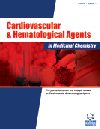- Home
- A-Z Publications
- Cardiovascular & Hematological Agents in Medicinal Chemistry (Formerly Current Medicinal Chemistry - Cardiovascular & Hematological Agents)
- Previous Issues
- Volume 21, Issue 2, 2023
Cardiovascular & Hematological Agents in Medicinal Chemistry (Formerly Current Medicinal Chemistry - Cardiovascular & Hematological Agents) - Volume 21, Issue 2, 2023
Volume 21, Issue 2, 2023
-
-
New Era: Mavacamten for Obstructive Hypertrophic Cardiomyopathy
More LessAuthors: Ma’Lik Woodland and Rami A. Al-HoraniObstructive hypertrophic cardiomyopathy results from asymmetric septal hypertrophy, which eventually obstructs the outflow of the left ventricle. Obstructive hypertrophic cardiomyopathy is linked to mutations in genes that encode for sarcomere proteins, including actin, β-myosin heavy chain, titin, and troponin. The mutations lead to structural abnormalities in myocytes and myofibrils, causing conduction irregularities an Read More
-
-
-
Therapeutic Potential of Stable Organosulfur Compounds of Aged Garlic
More LessAuthors: Kumkum Sharma and Vibha RaniAged garlic extract (AGE) is an odorless derivative of garlic prepared by extracting garlic cloves in an aqueous solution for twenty months. During the process of aging, reactive organosulfur compounds such as allicin present in garlic are converted to their stable isoforms such as S- Allyl cysteine. The unstable organo sulfurs in garlic (Allium sativum L.) have been reported to cause problems in the gastrointestinal (GI) tract Read More
-
-
-
Current Trends in Immuno-Oncology
More LessAuthors: Tulsi D. Patel, Venkata Gangadhar Vanteddu and Bawari SwetaSurgery, radiation, chemotherapy, and targeted therapy were the four basic kinds of cancer treatment until recently. Immuno-oncology (IO), or the concept that cancer cells were damaged by activating the body's immune system, has emerged and is explained as a unique and crucial method for treating different cancers over the last decade. The US Food and Drug Administration and the European Medicines Agency both appr Read More
-
-
-
Triazol-1-yl Benzamides Promote Anticoagulant Activity via Inhibition of Factor XIIa
More LessAuthors: Rami A. Al-Horani, Daniel K. Afosah and Madhusoodanan MottamalBackground: Human factor XIIa (FXIIa) is a plasma serine protease that plays a significant role in several physiological and pathological processes. Animal models have revealed an important contribution of FXIIa to thromboembolic diseases. Remarkably, animals and patients with FXII deficiency appear to have normal hemostasis. Thus, FXIIa inhibition may serve as a promising therapeutic strategy to attain safer and more effecti Read More
-
-
-
Antihyperglycemic and Antidyslipidemic Effects of Artemisia arborescens Aqueous Extract on Streptozotocin-induced Diabetic Rats
More LessAuthors: Amine Azzane, Omar Farid and Mohamed EddouksAims: This study aimed to investigate the antidiabetic activity of Artemisia arborescens. Background: Artemisia arborescens is an aromatic, medicinal, and endemic plant mostly found in the Mediterranean region. This plant is widely used as alternative medicine. Objective: The study was designed to examine the antihyperglycemic and antihyperlipidemic activities of Artemisia arborescens aqueous extract (AEAA) in norma Read More
-
-
-
Study of the Antihypertensive and Vasorelaxant Activities of Haloxylon scoparium in Rats
More LessAuthors: Smail Amtaghri and Mohamed EddouksAims: The work aimed to study the antihypertensive ability of Haloxylon scoparium. Background: Haloxylon scoparium Pomel is used to treat various diseases, including hypertension. Objective: This study aimed to evaluate the antihypertensive effect of Haloxylon scoparium (H. scoparium) in hypertensive rats, and to evaluate its probable vasorelaxant activity. Materials and Methods: The aqueous extract of Haloxylon scopari Read More
-
Volumes & issues
-
Volume 23 (2025)
-
Volume 22 (2024)
-
Volume 21 (2023)
-
Volume 20 (2022)
-
Volume 19 (2021)
-
Volume 18 (2020)
-
Volume 2 (2020)
-
Volume 17 (2019)
-
Volume 16 (2018)
-
Volume 15 (2017)
-
Volume 14 (2016)
-
Volume 13 (2015)
-
Volume 12 (2014)
-
Volume 11 (2013)
-
Volume 10 (2012)
-
Volume 9 (2011)
-
Volume 8 (2010)
-
Volume 7 (2009)
-
Volume 6 (2008)
-
Volume 5 (2007)
-
Volume 4 (2006)
Most Read This Month
Article
content/journals/chamc
Journal
10
5
false
en


